
Thiruvananthapuram, formerly known as Trivandrum, is the capital of the Indian state of Kerala. It is the most populous city in Kerala with a population of 957,730 as of 2011. The encompassing urban agglomeration population is around 1.68 million. Located on the west coast of India near the extreme south of the mainland, Thiruvananthapuram is a major information technology hub in Kerala and contributes 55% of the state's software exports as of 2016. Referred to by Mahatma Gandhi as the "Evergreen city of India", the city is characterised by its undulating terrain of low coastal hills.

The Kingdom of Travancore, also known as the Kingdom of Thiruvithamkoor, was an Indian kingdom from c. 1729 until 1949. It was ruled by the Travancore Royal Family from Padmanabhapuram, and later Thiruvananthapuram. At its zenith, the kingdom covered most of the south of modern-day Kerala and the southernmost part of modern-day Tamil Nadu with the Thachudaya Kaimal's enclave of Irinjalakuda Koodalmanikyam temple in the neighbouring Kingdom of Cochin. However Tangasseri area of Kollam city and Anchuthengu near Attingal in Thiruvananthapuram were parts of British India. Bordering the kingdom were the five Tamil-majority Taluks of Madras Presidency to the north, Madurai and Tirunelveli districts of Pandya Nadu region in Madras Presidency to the east, the Indian Ocean to the south, and the Arabian Sea to the west. As of the 1911 Census of India, Travancore was divided into five: Padmanabhapuram, Trivandrum, Quilon, Kottayam, and Devikulam, of which the first and last were predominantly Tamil-speaking areas.
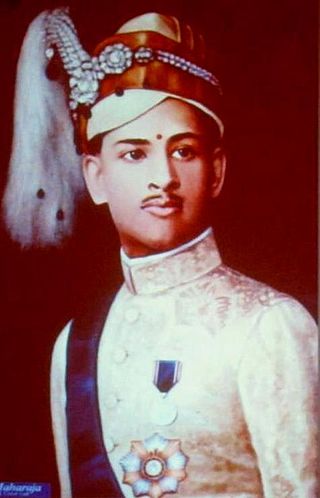
Sree Padmanabhadasa Sree Chithira Thirunal Balarama Varma, popularly known as Sree Chithira Thirunal, was the last ruling Maharaja of the Indian princely state of Travancore, in southern India until 1949 and later the Titular Maharajah of Travancore until 1991. His reign is known for several notable reforms that have indelible impact on the society and culture of Kerala.
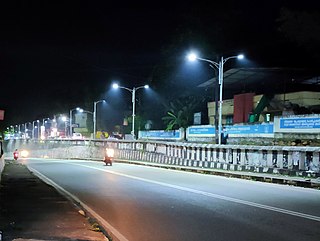
VarkalaIPA: [ʋar̥kala] is a major coastal municipality situated in the northern suburb of Trivandrum, capital city of the Indian state of Kerala. It is the headquarters of Varkala Taluk and important government institutions such as the taluk office, court complex, office of the Deputy Superintendent of Police, Legal Metrology Inspector office, Excise Circle and Range office, RTO, Treasury and Mini civil station are situated in here. It is one among the oldest municipalities of Kerala established on 1980.

Thiruvananthapuram District, is the southernmost district in the Indian state of Kerala. The district was created in 1949, with its headquarters in the city of Thiruvananthapuram, which is also Kerala's administrative centre. The present district was created in 1956 by separating the four southernmost Taluks of the erstwhile district to form Kanyakumari district. The city of Thiruvananthapuram is also known as the Information technology capital of the State, since it is home to the first and largest IT park in India, Technopark, established in 1990. The district is home to more than 9% of total population of the state.

Sree Chitra Tirunal Institute for Medical Sciences and Technology (SCTIMST), formerly Sree Chitra Tirunal Medical Center, is an autonomous medical school and an Institute of National Importance in India established in 1976 at Thiruvananthapuram, Kerala. The institute is named after Chithira Tirunal Balarama Varma, the last Maharajah of Travancore, who gifted the building. The institute is under the Administrative Control of the Department of Science and Technology, Government of India. SCTIMST is one of the most prominent research Institutes and centers in India.
The history of Thiruvananthapuram dates back to the 18th century AD. In 1795, the city became the capital of the princely state of Travancore. Several historic landmarks of the city, including the Kowdiar Palace, University of Kerala, and Napier Museum were built during that period. After independence, Thiruvananthapuram was made the capital of the state of Kerala.

The city of Thiruvananthapuram has been the centre of cultural activities of Kerala (India) from the time it was made capital of Travancore in 1745. The capital city is a major intellectual and artistic center. The Thiruvananthapuram Museum and Thiruvananthapuram Zoo were started during the reign of Swathi Thirunal (1813–1847) and are one of the oldest of their kind in India. The city's libraries include the Trivandrum Public library, which was started in 1829. The Swathi Thirunal College of Music and 'College of fine arts' are the leading institutions related to music and arts.

Kerala State Road Transport Corporation (KSRTC) is a state-owned road transport corporation in the Indian state of Kerala. It is one of the country's oldest state-run public bus transport services. The corporation is divided into three zones, and its headquarters is in the state capital Thiruvananthapuram. Daily scheduled service has increased from 1,200,000 kilometres (750,000 mi) to 1,422,546 kilometres (883,929 mi), using 6,241 buses on 6,389 routes. The corporation transports an average of 3.145 million commuters per day.

Meenmutty Falls is a waterfall located 45 kilometres (28 mi) from Trivandrum city in Thiruvananthapuram District in the Indian state of Kerala, India. The falls are located near the Ponmudi hill station, Thiruvananthapuram district and Agastya Mala Biosphere reserves. This waterfalls is situated along the upper riparian course of Vamanapuram River.

Kulathupuzha is a town in the east part of Kollam district of Kerala, India. It is one of the important pilgrim spots linked with the legend of Sabarimala. Kulathupuzha is also the birthplace of the Malayalam music legend Raveendran. Kulathupuzha is the source of the Kallada river, Thenmala Dam(KIP) is located on this river. As declared by Governor Arif Mohammad Khan, Kulathupuzha panchayat is the first in India to have achieved Constitution-literacy.

The Thiruvananthapuram Zoo is located in the city of Thiruvananthapuram, the capital of Kerala, India. It occupies 55 acres (22 ha) of woodland, lakes, and lawns.

Visakham Thirunal Rama VarmaFRAS was the Maharaja of the erstwhile Indian kingdom of Travancore from 1880 to 1885 AD. He succeeded his elder brother Maharajah Ayilyam Thirunal to the throne of Travancore.
Pattom is a dense commercial region of Thiruvananthapuram city in Kerala, India. It is located approximately 4 kilometres north of centre of Thampanoor. Pattom is largely a residential area, also housing few important administration offices of Kerala State and a few shopping complexes. It has offices of Kerala Public Service Commission, Kerala State Planning Board, Life Insurance Corporation of India, Thiruvananthapuram Divisional Office, LIC Housing Finance Limited, State Resource Centre, District Panjayat Headquarters, Fire and Rescue Department Headquarters, Kerala Co-operative Milk Marketing Federation (Milma), Employees Provident Fund Regional Office and Kerala State Electricity Board. The Traffic Police and Telecommunication department, and the Kerala Science, Technology and Environment Head Office are also located in Pattom.
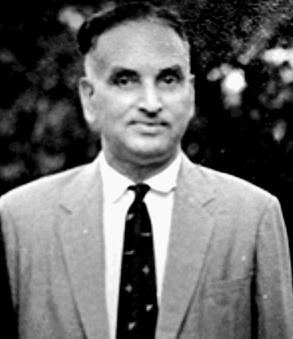
Lt. Col. P. R. Godavarma Raja, often referred to as G. V. Raja, was an Indian sports and tourism promoter and administrator, pilot, sportsman and Sanskrit scholar. He took special care in inspiring the youth into sports and was instrumental in founding the Kerala Sports Council in 1953. G. V. Raja occupied the post of Council President till he was killed in a flight mishap in 1971. G. V. Raja also played a key role in establishing the Trivandrum Tennis Club, Flying Club, and the development of the Thiruvananthapuram International Airport. As the spouse of Karthika Thirunal Lakshmi Bayi, he became the prince consort of Travancore.

Kanakakkunnu Palace is situated in Thiruvananthapuram near the Napier museum, India. It is India's first digital garden, created by Akhilesh S. V. Nair and A. Gangaprasad, University of Kerala, Department of Botany.
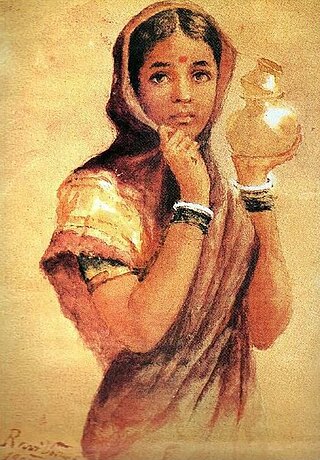
Sree Chitra Art Gallery is an art gallery in Thiruvananthapuram, India, established in 1935. It is located in the northern grounds of the Napier Museum. It was inaugurated by Chithira Thirunal Balarama Varma. The gallery features a unique collection of traditional and contemporary paintings, including the works of Raja Ravi Varma, Nicholas Roerich, Svetoslav Roerich, Jamini Roy, Rabindranath Tagore, V. S. Valiathan, C. Raja Raja Varma, and K. C. S. Paniker. There are approximately 1100 paintings at the gallery.
Trivandrum Rubber Works is a public sector manufacturing industry in Thiruvananthapuram, Kerala, India. Its manufactured products include, retreaded metals, bonding gum and unvulcanised sheets. It was promoted by Kerala State Industrial Development Corporation (KSIDC).
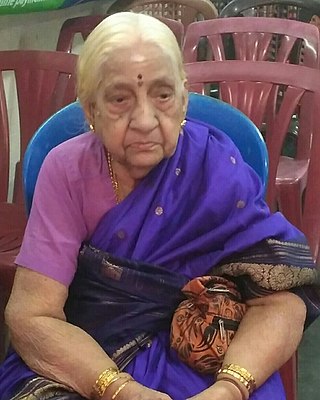
Parassala B. Ponnammal was an Indian Carnatic musician from the south Indian state of Kerala. She was a classical carnatic vocalist in the lineage of Semmangudi Srinivasa Iyer, Muthiah Bhagavathar, and Papanasam Sivan. She was the first woman to perform at the Navaratri Mandapam in Thiruvananthapuram as a part of the Navaratri Celebrations of the Sri Padmanabhaswamy temple in Kerala.

















